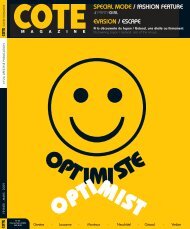Create successful ePaper yourself
Turn your PDF publications into a flip-book with our unique Google optimized e-Paper software.
STORY<br />
50<br />
tendance / trends<br />
219,<br />
//////////////////////////////////////////////////////////////////////////////////////////////////////////////////////////////////////////////////////////////////////////////////////////<br />
L’HISTOIRE CONTINUE<br />
219, THE STORY CONTINUES...<br />
219, la marque horlogère à durée de vie limitée est la<br />
seule à avoir recours à la la numérologie maya pour<br />
indiquer l’heure. Elle possède une patente d’exclusivité<br />
– louée à un historien genevois – pour utiliser ces<br />
indexes en numérologie maya et pour une représentation<br />
horlogère du calendrier du compte long. Ce système<br />
de numérologie maya est du type répétito-additif dans<br />
lequel les barres et les points se combinent pour donner<br />
des chiffres.-/ 219, the mechanical watch programmed<br />
to 'self destruct' at the much-discussed 'end of time' in<br />
2012, is the only modern timepiece displaying time<br />
according to the Mayan numerology system. The watch<br />
has an exclusive patent – from a Geneva historian – to<br />
use the Mayan indices and a representation of the 'long<br />
countdown' of the Mayan calendar. Mayan nuerology<br />
uses a repetitive-additive system of bars and dots to<br />
represent numbers.<br />
Le modèle KUKULKÁN tire son nom du dieu maya<br />
éponyme, également appelé le Destructeur des<br />
nations, le Dieu Vengeur, le Dieu de l’Est ou le serpent<br />
à plumes. Il est l’équivalent, chez les Mayas du<br />
Yucatan, du dieu aztèque Quetzalcoatl. Sur la majorité<br />
des pyramides ou temples mayas, on retrouve des bas<br />
reliefs du serpent à plumes, considéré comme une des<br />
divinités les plus importantes de la mythologie maya.<br />
La légende raconte qu’un prêtre maya à barbe et à la<br />
peau très blanche fut avalé par un serpent. Pour<br />
échapper à ce sort tragique, il tua le reptile de l’intérieur,<br />
mais se trouva transformé en serpent à plumes et<br />
puis chassé vers l’Est. L’histoire prédit que<br />
KUKULKÁN reviendrait en l’année 1 du cycle du<br />
roseau. Le destin voulu qu’Hernán Cortés débarqua<br />
avec ses troupes et soit ainsi confondu avec le serpent<br />
à plumes. En effet, sa barbe, sa peau blanche et son<br />
cheval (animal encore jamais vu par les Mayas et les<br />
Aztèques) donnèrent l’impression aux indiens d’être un<br />
Dieu vivant. L’histoire donna raison à la prophétie, le<br />
serpent à plumes alias Cortés renversa des civilisations.<br />
La légende continue encore aujourd’hui, à chaque<br />
équinoxe de printemps et d’automne, l’ombre de<br />
KUKULKÁN apparaît sur la pyramide de Chichen Itzá<br />
dans la péninsule du Yucatan…<br />
www.219.ch<br />
avril - mai 2011 www.cotemagazine.com<br />
-/ The KUKULKÁN model takes its name from the<br />
eponymous Mayan god, also known as the<br />
Destroyer of Nations, the God of Vengeance, the<br />
God of the East or the Plumed Serpent. For the<br />
Yucatan Mayans, he is the equivalent of the Aztec<br />
god Quetzalcoatl. Mayan pyramids and temples all<br />
feature relief carvings of the Plumed Serpent deity.<br />
Legend has it that a Mayan priest with white skin<br />
and beard was swallowed by a serpent. To escape<br />
his tragic fate, he killed the reptile from inside its<br />
belly, but found himself turned into a plumed serpent,<br />
and banished to the East. The story predicted<br />
PAR AU<strong>DE</strong> MULLER<br />
that KUKULKÁN would return in year 1 of the 'reed<br />
cycle'. Inevitably, when the conquistador Cortès landed<br />
with his troops, he was mistaken for Kukulkan in<br />
person – his pale skin, beard and horse (an animal<br />
never before seen by the Mayans and Aztecs) led<br />
the Indians to greet him as a living god. The prophecy<br />
came true: this particular Plumed Serpent god<br />
was indeed the destroyer of the Mayan and Aztec<br />
civilisations.<br />
Today, the legend continues. Each year, at the<br />
spring and autumn equinoxes, the sinuous form of<br />
KUKULKÁN appears on the pyramid of Chichen Itzá<br />
on the Yucatan peninsula.<br />
BANQUE GENEVOISE <strong>DE</strong> GESTION SA<br />
Rue Rodolphe-Toepffer 15, 1206 Genève<br />
Tél. : + 41 22 347 90 40 - Fax : + 41 22 347 93 27 - www.bgg.ch

















